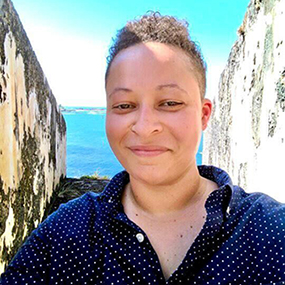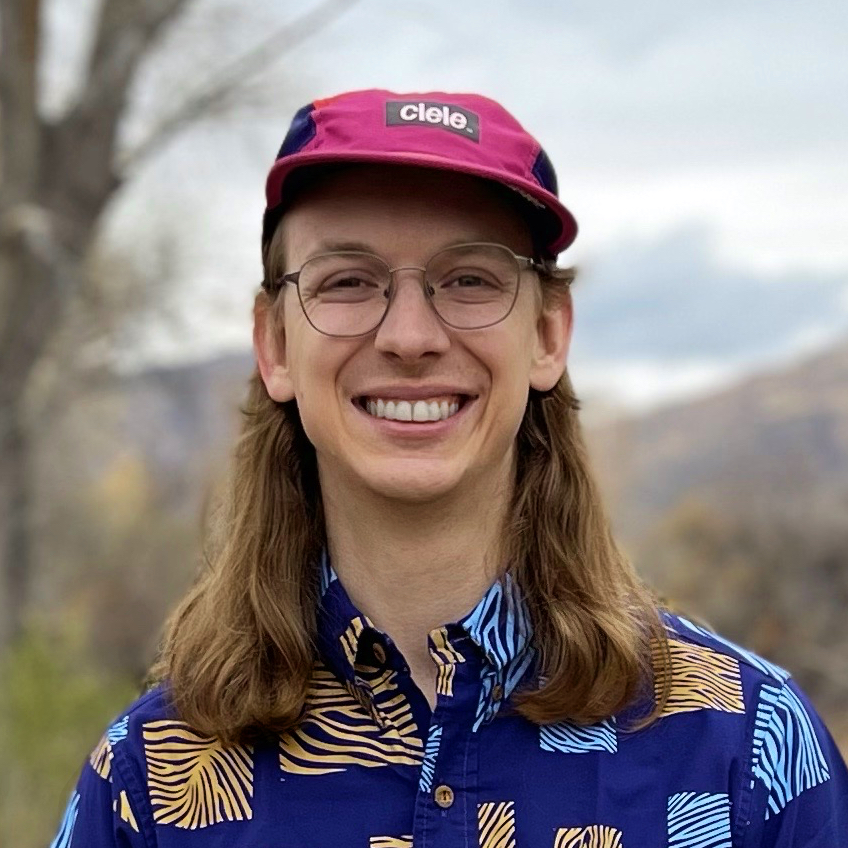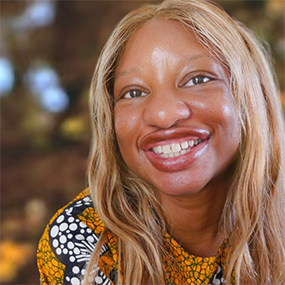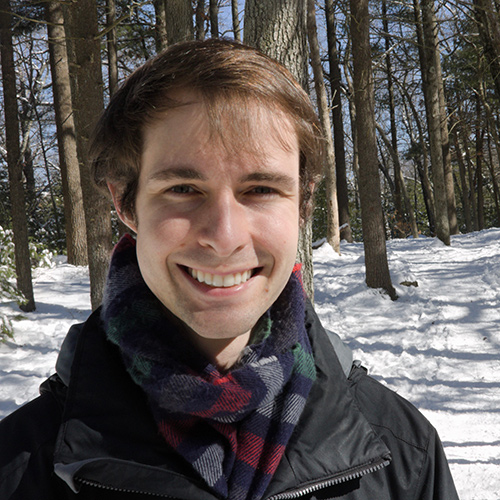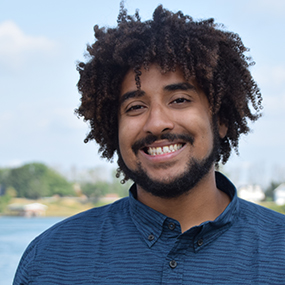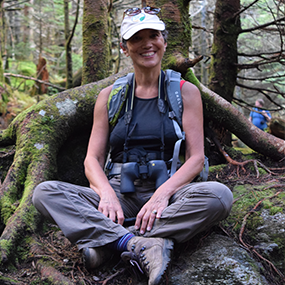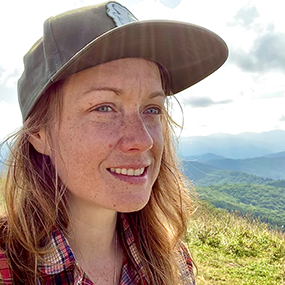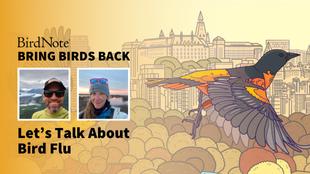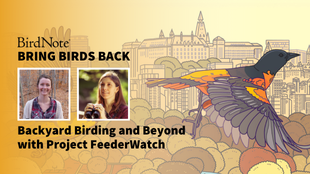

Join BirdNote tomorrow, November 30th!
Illustrator David Sibley and actor H. Jon Benjamin will face off in the bird illustration battle of the century during BirdNote's Year-end Celebration and Auction!
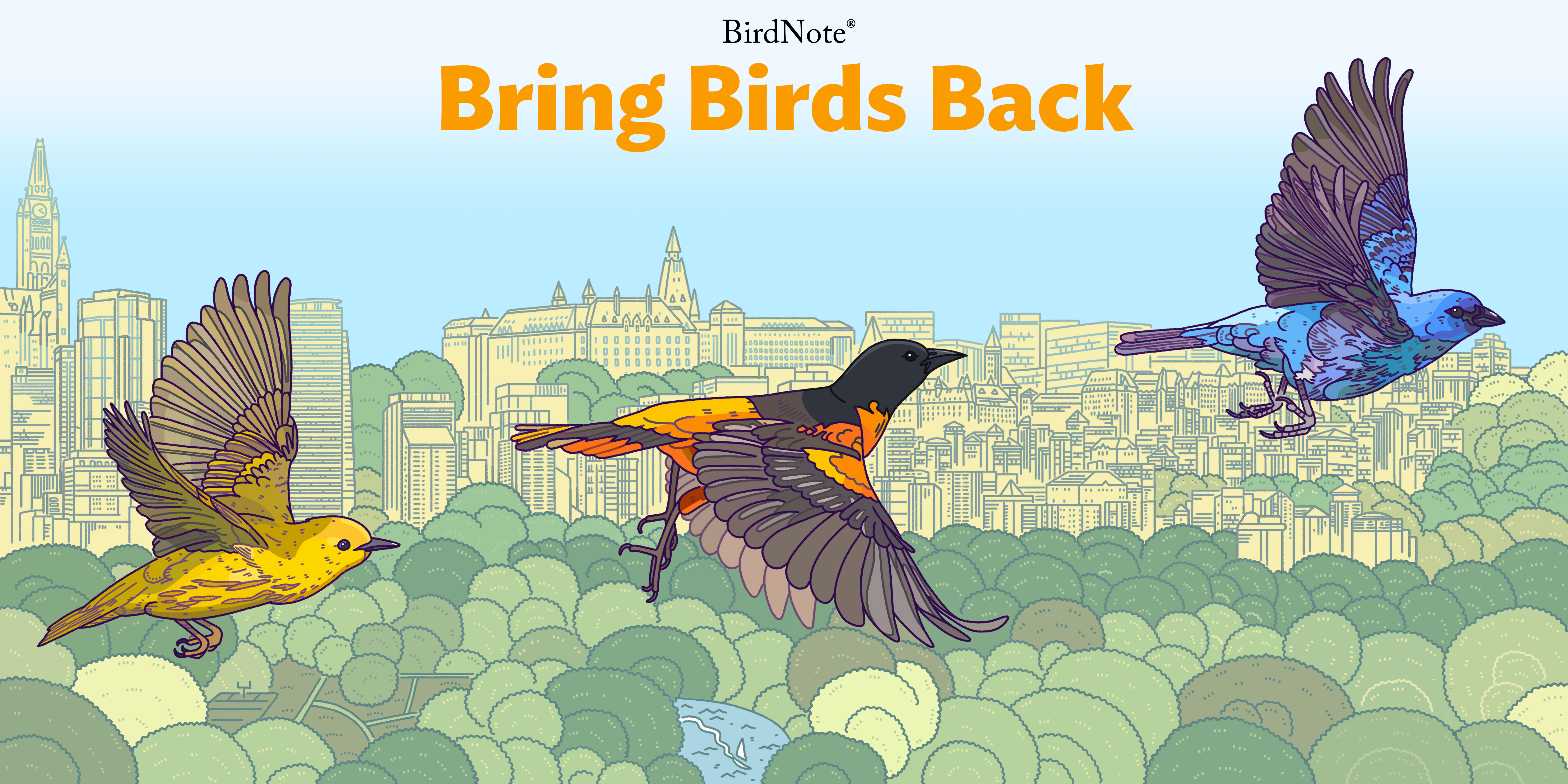
Have you ever worried you’d hit a wild animal while driving down a highway or country road? In this special season closer, we learn about a new and promising future for wildlife and battered cars: wildways. As technology and development continue to expand, infrastructure and fragmentation are threatening the habitats of wildlife. Christine Laporte explains how wildways bridge the gap between the natural world and rapidly growing cities. And then, Dr. Liz Hillard gives us a glimpse into what it all looks like in real time as evidence of its success rolls in. Co-produced by our guest host, Marcus Rosten. Press play!
For more information about the From Love to Action campaign, episode transcript and other resources from this episode, visit BirdNote.org.
Want more Bring Birds Back? Subscribe to our show and follow us on Instagram! For more about BirdNote, sign up for our weekly newsletter. And for ad-free listening and other perks, sign up for BirdNote+ here.
BirdNote is a nonprofit. Your tax-deductible gift makes these shows possible.
Bring Birds Back Special Season 5 is sponsored by the Cornell Lab of Ornithology.
Marcus Rosten: BirdNote Presents:
This is Bring Birds Back. I'm your guest host, Marcus Rosten, a naturalist based in Buffalo, working to conserve the ecology of Western New York.
On Bring Birds Back, we’ve talked a bunch about unequal access to parks and natural spaces. Something we don’t usually think about, though, is how this issue extends to wildlife, too.
[Driving, upbeat music starts]
Take a trip back in time with me… let’s say about 500 years ago, to the pre-colonized United States, before Europeans. And imagine that you’re a Black Bear, just roaming your home range. Your territory could stretch over 50 square miles — that’s over 24,000 American football fields. You could roam and ramble your range unbothered and unencumbered.
But, today? If you tried to take that very same stroll, your journey would be much more treacherous.
Highways, neighborhoods, and human development have fragmented the landscape at a dizzying rate — for example, as of 2020, there’s over 4 million miles of road in the US — and wildlife are suffering the repercussions.
My fellow bird-nerds might be familiar with the concept of flyways, the typical routes taken by migrating birds between their overwintering in the south and their breeding ranges up north. These journeys span all continents and oceans, with each species belonging to a unique pathway of their own.
But what about the wildlife without wings? That’s where Wildways come into play.
A Wildway is essentially a flyway for mammals and other land-based organisms. It’s a system of protected core areas that reconnect the landscape and relink wildlife back to their migration paths.
It's a relatively new concept inspired by Indigenous practices, and I recently began a new role making it a reality as the Director of the Western New York Wildway.
Today, you’ll hear from my future collaborators, Dr. Liz Hillard and Christine Laporte of the Wildlands Network. Liz is the Senior Wildlife Biologist of the Appalachian Region, we’ll hear about her work later. First up is Christine Laporte, the Eastern Program Director.
[Music ends]
Marcus Rosten: Alright, Christine. Thanks for being here. Can you help me dive into more of the history of wildways, how they function, and why they’re important? What defines a wildway?
Christine Laporte: Absolutely, thank you. One of the key concepts of a wildway is that there's connectivity between landscape. The one that I work on ranges from Nova Scotia through Florida. So just visualize that as one big fabric. And what happens within a wildway is sometimes that fabric gets severed by highways, roads, human density and development.
Marcus Rosten: Right, so that gets at the why of this issue — why are wildways necessary? Can you share a little about the history of what’s happened to wildlife in North America that’s brought us to this point?
Christine Laporte: What happened to wildlife in America? What we call America. I mean, my mind immediately goes to colonization and everything that came with that. And the indigenous peoples who lived in North America called Turtle Island to many tribes and First Nations certainly harvested wildlife for food, interacted with wildlife in ways that meant taking of lives, but the relationship was completely different than the Western view that was brought, which was extractive and just a different way of looking at the world.
You start to see massive fragmentation of landscape as the indigenous and the wildlife began to be pushed west from the east, I'm talking decades in from colonization, you see huge agricultural swaths where forests used to be intact, and you see the introduction in some cases of, insects or other kinds of organisms that affect forest trees, so forest trees dying out, changing the ecosystem structure. I mean, think about the bison. There used to be cougars and wolves in many, many, many, many places that they no longer are. So there was an intact fabric of how wildlife interacted.
Marcus Rosten: OK, so when did the idea for wildways come about? Where did this all start?
Christine Laporte: Wildways emerged as a concept in conservation back in the 80s through an interesting confluence of some wild and wilderness advocates, and some conservation scientists.
And through that interesting mix of worldviews, conservation biology was born. It's a discipline within ecosystem studies. And these two rivers of thought, so the wild people, I love calling them the wild people, they founded Wildlands Project and part of their motivation was this shared value that all species have an absolute right to exist.
And zooming out to landscape level, looking at how does North America work? How do the ecosystems work? How do the plants and animals and lichens and everybody, how do the rivers work? So through that great marriage of different world views, wildways are such an optimistic and audacious way of looking to the future. It's not just about what we can protect now, but we, we really do have a 500 year vision at Wildlands Network. And that's why I think it's important to imagine what we want in the future and talk about it with the younger generation so that they start having creative thoughts about what they want the landscape to look like as well. And that we can do in the immediate time scale, passing that along to the younger generation.
Marcus Rosten: So you have this 500 year plan at Wildlands Network — how do you go about making this vision a reality?
Christine Laporte: The first step is to prove that wildlife vehicle collisions are terrible for humans as well as other species. So we do a lot of research or we work with those who have already done the research. For example, here in North Carolina, after several years work, we just published a report recommending the top 20 wildlife crossing sites in North Carolina. Our Southern Appalachian chief scientist, Liz Hillard, has been studying the impacts and the wildlife crossings that exist, and putting all that kind of different data together.
We did that prioritization ourselves, but we vetted it with a lot of the Department of Transportation and wildlife professionals and researchers in the state. So that's an example where science really fed into the agency process.
Marcus Rosten: And I got to talk with Liz Hillard about her experience making wildways happen, on-the-ground.
Liz Hillard: I'm coming to everybody from Asheville, North Carolina, where I am the Senior Wildlife Biologist for Wildlands Network. The research I'm doing really can be applied and lead to real movement forward.
And I'm just very inspired and passionate by that piece of this. The research specifically on Interstate 40, where it runs through Pigeon River Gorge, which is essentially the western boundary of Great Smoky Mountains National Park.
It has so much National protected Forest land on both sides, and everyone had been citing this area as a bear mortality hotspot. And we have this growing elk population and we have deer mortality out there. We did four years of focused research, both with elk GPS collars, collecting as much wildlife road mortality data, you know, actual locations of where animals are getting hit and incorporating all of that information along with 150 cameras monitoring animal activity throughout this section of Interstate to really try to cite and understand better: where would it be best to put in road infrastructure that not only reduces vehicle collisions but really connects the landscape. Our whole piece is making sure we have a connected landscape through time so wildlife can thrive.
Marcus Rosten: Yeah, like you said, we already have an infrastructure problem in the United States that we have to tackle. Might as well tackle that problem and then make it better for wildlife at the same time. And I know up in New York State, you're holding your breath anytime you're driving around at night because you're just waiting for that deer to cross out in front of you. You don't want to hit a deer any more than that deer wants to get hit.
[Concerning music starts]
Marcus Rosten: So I guess, touching on that habitat fragmentation, what does that do to a population of elk? I think the most obvious effect that we can imagine is roadways being a dangerous place for animals to travel and collisions with vehicles are catastrophic and deadly. But I'm assuming that the effect of this habitat fragmentation goes a lot deeper than that. Can you tell us, like, how that really changes, you know, entire populations of elk and other animals?
Liz Hillard: Oh yeah. And so I think what's interesting is we all know about wildlife vehicle collisions and road mortality, and the numbers are absolutely staggering. So it's estimated that tens of millions of birds, reptiles, amphibians, and mammals are killed per year on U.S. roadways. And for birds specifically, a recent study just estimated that between 89 million and 340 million birds die annually in vehicle collisions on U.S. roads.
And while that amount of wildlife mortality is almost impossible to fathom and wrap your head around, the issue is actually much larger. Because beyond mortality, they create these barrier effects, and that restricts animal movements. And those restrictions limit wildlife's access to food and habitat resources, as well as mates. And through time, that can lead to the progressive isolation of local populations and high rates of inbreeding.
And so, if we have isolated local populations and we have some sort of catastrophic event, or if they have high rates of inbreeding and are all so genetically similar, a disease or something that comes through there makes those populations much more vulnerable.
So roads creating this isolation, not being able to get to mates, not being able to access food resources, overall threaten biodiversity by decreasing species abundance
[Music ends]
Marcus Rosten: You’ve spent a lot of time watching these wildlife cameras in studying these animal crossings — were there any favorite moments that stood out to you?
Liz Hillard: Oh, there were so many, but I'm going to go with this one, just because I was very tied to the elk. I was monitoring elk with GPS collars, and I'm getting location from them every hour, and I can watch that in real time. In early spring, female elk, cow elk, make larger movements because they go and have their calf on their own.
And this female cow elk every year crosses the interstate at road grade. And I saw her through time cross the interstate almost 107 times through the three years of monitoring her. And I was always curious if she had a calf or not, and if she was bringing that calf back successfully.
And in the cameras that we had monitoring the structures. I got to watch her leave on her own, go to the other side of the interstate, have her calf and bring that calf back. And I watched her do that two years in a row. People always ask, why? Why did she do that?
And animal behavior is as complex as human behavior, but I would imagine it's just space. She needed space, because they want to be alone. And so, she did this kind of death defying passage of Interstate 40, and two years in a row, had a calf on the other side and brought it back, and I was able to see that through the camera images.
Marcus Rosten: Wow that interaction makes this issue feel so much more real. Shifting gears a bit, how would you explain the importance of habitat connectivity to someone just learning about it?
Liz Hillard: I think one of my favorite examples is black bears here in the Appalachian Mountains. Black bears are really dependent on acorns. And we know that acorns, both red and white acorns, they have high mast years, years where they produce a lot of acorns, and years where there's what they call mast failure, where the trees don't produce a lot of acorns. And that's cyclical, and sometimes it changes regionally, but in those years where we know it's a bad acorn year, and there's not a lot of acorns available, it's exponential in bear mortality along roadways, because due to the fragmentation of the habitat, bears can't find acorns in their smaller fragmented areas.
So they need to move larger distances to go find food. That puts them coming up across roads and human developments constantly, and that's why we see, in years with not a lot of acorns, a lot of bear mortality on the roadway.
The roads and, and fragmentation development that reduces foods that are available make wildlife have to move farther, and that's where they can get into trouble.
I would say in the last 50 to 70 years just- our increase in creating large interstate roadways, just throughout areas, and a good example of that is again the Pigeon River Gorge. That interstate was built in 1960, so it hasn't been there that long. And prior, that was a decently, if I may use it, pristine area with very few roads running through this completely rugged gorge.
And so when these roadways are built, if you can all imagine, we're blowing up mountaintops. And using bears again, they are ridgetop walkers, just like a lot of wildlife. And so in these areas where you see all the mountains being blown up to create these roadways, I mean, they're just disconnecting mountaintops in which wildlife can move along.
Marcus Rosten: The way you describe it, it's almost as if these roads are turning habitats into islands, and these elk are just getting trapped on islands and only stuck with the populations that are around them. And yeah, it just limits your availability to find mates to diversify your gene pool. And outside of elk, I know that you've done a ton of field work monitoring animals in the Pigeon River Gorge.
What are some of the other animals that you have studied, and what are you finding in North Carolina when it comes to this habitat fragmentation?
Liz Hillard: For these larger mammals, similar to wildlife habitat, there's kind of winners and losers, right? And how big you are and how fast you move plays a lot into how extreme the barrier effect is, right? So really for elk, they're easy for us to see in cameras, when they're killed on the road we see them, they're easy to put collars on.
But when it comes down to it, it's the smaller species. It's the species of conservation concern. Things like reptiles and amphibians and small mammals that this is taking a toll on, if we can imagine, those animals having a harder time moving over roadways.
And so it's been so exciting. I mean, diverse wildlife are omnipresent along this very busy roadway that has, like, a five foot concrete barrier in between it. I mean, crossing there, for something small, seems absolutely impossible. And I worry that the solutions aren't being focused maybe where they should be on some of these smaller animals.
So, a diversity of wildlife from a bunch of wood rats to spotted skunks to bobcats, grey foxes, red foxes, eastern cottontails, copperhead snakes, timber rattlesnakes, a diversity of salamanders, eastern box turtles. You know, what gets difficult with the larger structures is their cost. They're very hard to afford. But, I'm excited to be working with these, lesser known or species of concern — animals that, I really think we could make some leeway on if we can get these smaller experimental structures throughout the Appalachian area to help our wildlife such as, like, timber rattlesnakes, who are so cryptic and move so slow.
And so while roads aren't necessarily the number one factor that are reducing, you know, black bear, white tailed deer, elk populations, they are the number one factor impacting populations of timber rattlesnakes that I know y'all have up there, and we have throughout the region, and turtles as well.
Marcus Rosten: I'm glad that you brought up amphibians, too, because that's something that we, up here in New York State, we also, you know, give some attention to. Spotted salamander migration. We have crews that will go out on those warm, rainy spring nights just to help salamanders cross the road. And it's one of those things where those smaller animals, they might not get as much visibility or publicity, but they could be impacted, you know, even more than, like you mentioned, some of those bigger animals that can make it across the road.
[Calm banjo music starts]
Marcus Rosten: We’re gonna take a quick break, but when we come back we’ll hear how Liz’s work helps find the most effective places for wildway infrastructure, why connecting with partners is crucial to success, and what we all can do to help. Stick around.
[MIDROLL]
Marcus Rosten: So a key part of wildways is reconnecting habitat across roadways. There are two main kinds of infrastructure that can be installed for passage: wildlife bridges or overpasses, and culverts or underpasses.
The bridges are pretty self-explanatory, and are usually what the bigger animals, like elk, need to travel over a road.
A culvert is essentially a pipe that runs under the roadway — they’re often used for drainage, but if placed strategically and sized correctly they can also be used by wildlife, like the snakes, turtles, foxes and salamanders that Liz Hillard mentioned.
But there’s a lot of work that goes into determining where these structures would be most beneficial.
Liz Hillard: Wildlands Network specifically, and a lot of other organizations, we come up with mapping where we identify what we think are core habitat areas. They tend to be protected or just forested and, um, you know, good habitat. And then we see all the fragmentation and we identify where we think corridors should be created to move between those. Once we kind of have some ideas of that, what makes it easier for us is really focusing then on a place like Great Smoky Mountains National Park, interstates running along it, and about 75 percent of that roadway has adjacent national forest land on both sides.
I mean there's a lot of opportunities to be doing this work, but roadways specifically, that allows us to then key in, where are these protected areas? Oh, it's protected areas on both sides of Interstate 40 through this gorge for 28 miles. The big part there was getting groups of people together, the Tennessee Department of Transportation, North Carolina, the federal agencies, the Park Service, and really starting a coalition there. Getting local folks, uh, bought in and understanding that we need their expertise.
We bring in road ecology experts and really talk about the issue, come together and really create a study design. And we did driving surveys to mark actual locations of where bear, deer, and elk are getting hit, and then getting information from the maintenance folks.
So we had around 200 locations of vehicle mortality spatially along this roadway. We put up wildlife cameras and we use those as a proxy to index wildlife activity throughout the roadway. And then the GPS elk collars, looking at where elk are not only crossing the road, but also using that right of way. And then creating some connectivity models.
And so the foundation of kind of gathering all this info and applying it to the road, extract all that information, and kind of, look at where is mortality high. And at the same time, we really tried to ask: what on the landscape might be influencing where these vehicle collisions happen. You can see that it's not random.
Marcus Rosten: So, you’ve collected all of this data. What’s some of the most important information you’ve learned?
[Mischievous music starts]
Liz Hillard: One of our biggest findings really was that these vehicle collisions, there's a higher probability of these happening near where current infrastructure already exists on the landscape. So we monitored those with cameras and, you know, tallied the number of animals that successfully crossed.
And so we knew what structures were crossing wildlife and what weren't. What's happening is: They move through the landscape as a path of least resistance, right?
You're trying to save energy, you're not going to be scaling up a large mountain, and so we've really created our infrastructure, our roadways, also along these paths of least resistance, as well as: they're following the riparian corridors, which we know that streams and rivers are so important for wildlife movement.
They end up along a road where there's a bridge or along the water where there's a culvert and so that's forcing them to have to cross at road grade, where they're getting hit.
Most wildlife have a specific home range, usually a large area that they need to be able to find all of their resources in. What happens when we have human development that limits that, it reduces that habitat, fragmenting it, or a road runs right through the middle of a large parcel of important habitat. That's fragmenting it, reducing the size of the habitat in a large chunk that can be accessible where these resources are available.
Marcus Rosten: OK, so you build wildway infrastructure, these culverts and bridges, to help wildlife. But it’s not like elk and snakes are using Google Maps, right?
Siri Voice: At the next culvert, slither right.
Marcus Rosten: There’s nothing telling them, go a mile down the highway to this nice safe bridge. How do they know where to go, or how do you get them to use it?
Liz Hillard: It really comes down to the fencing piece, which actually is like the less glamorous part of all this. But fencing is really necessary, not only to guide the wildlife to that crossing, but keep them off of the roadway.
Especially for ungulates, so elk and deer. We have a lot of metrics knowing that they really prefer larger structures, they need a line of sight. Since they're, uh, prey, they wanna be able to see.
But things like black bears and mountain lions are okay with using smaller tunnely structures. And so, what's incredible is wildlife really seem to be happy to use these.
Marcus Rosten: Now, all this research is great, but the data alone isn't going to save wildlife. That has to be turned into policy and infrastructure. Like Christine Laporte mentioned earlier, Liz worked with government officials to implement changes based on her research.
Liz Hillard: The North Carolina Department of Transportation invited us to a meeting to let us know that: hey, we're replacing five bridges within the study area in the next five years.
So, it's coming up soon. And when we know there's infrastructure changes coming in, that's where we can come in and ask for a larger bridge span, so that wildlife can move underneath and they're not forced to be on the road. They allowed us to give input on how the new bridges could be easily modified, ‘cause those plans were already accepted, to move wildlife through them. And they accepted those recommendations and put them in their plans.
That's been a huge win, I thought it would be a real battle to get in the door, but it was kind of open for us, which surprised me.
Marcus Rosten: That said, these projects are inherently expensive. For example, Wildlands and others were able to get the North Carolina government to appropriate five million dollars to use for wildlife crossings in the state, but that money doesn't go as far as you might think.
Liz Hillard: Right, so $5 million, that sounds like a decent amount; when it comes to infrastructure, that would probably be a pretty cheap overpass. But where it does help is that we tend to have match funds, like for the wildlife crossing pilot program, it's a one to nine match, so that five million ends up being a lot more money.
I think that, given the start of this large project and the work that the North Carolina Wildlife Resource Commission is already doing in other parts of the state, that roads and wildlife crossings over roads is gonna be just improving through time. And we're gonna be learning more and folks in all agencies are gonna know more about this process.
Marcus Rosten: While Liz came to this project with her expertise in crunching numbers and statistics, her biggest takeaway was finding what truly impacts change.
Liz Hillard: Being a research person, coming out with my PhD, I just thought data drove everything. And it's an important piece of this to check the box. But what I found with the Pigeon River Gorge, we used the research to really communicate what we were doing out there, build a coalition, the photos we're getting, the wildlife, the mapping and allowing the public to understand the issue, so having that information, but also being able to constantly update through our four years of research all of our partners, and so this allowed us to kind of all coalesce around this.
And we've built this large coalition, the Safe Passage Coalition, and in that coalition is what's given us a little more power to be at the table with such a large backing and being able to show that we've been working together for a while. And so what's interesting is that actually all comes down to the local community and getting everybody involved.
Marcus Rosten: The Safe Passage Fund Coalition brings together people like Liz and her team at the Wildlands Network with other aligned organizations to do outreach, education, and fundraising for wildway infrastructure. They were instrumental in securing that $5 million for wildlife crossings in North Carolina we mentioned earlier.
And this isn't the only partnership the Wildlands Network has forged to help realize its vision — far from it. Christine Laporte, who we heard from earlier, does a lot of work building those relationships. Like working with the state of New York on its 30 by 30 initiative, that requires 30 percent of the state’s land and water to be protected by 2030. And another program she's especially excited about:
Christine Laporte: Future Forests Reimagined is an initiative that we co-founded up in the Northern Appalachians, Acadian, Wabanaki bioregion. So it goes way up from New York up into parts of Quebec, New Brunswick, and Nova Scotia.
We were guided the entire way by how to frame how we want our future forests in that region to look.
We were guided by the indigenous leaders of several members of different communities within the Wabanaki Confederacy, Dawnland Confederacy. And so that for me, while it's not quite on the ground yet, the fact that we came together and we're making progress at the pace of trust that we're building with the Indigenous people as well as the other communities, it's the future.
And a lot of what I call the Wildway vision is already being implemented on the land by many tribal resource managers, many tribes and their relationship and how they manage their forests. So I'm still, sort of, documenting that up north.
Marcus Rosten: I’m curious, looking to the future, what would you like to see change? Beyond these projects, how else can this wildway vision be realized?
Christine Laporte: I mean, we have to be careful and think about how we design our cities, how we design where we live. So I think there's a lot of opportunity in creative design for how humans live. In our cities, in our towns, in our rural areas.
Liz Hillard: What I'd really like to see is that this is just mandated. Anytime you're building a road, anytime you have a road project, a wildlife mitigation tool or solution needs to be put in place there.
Marcus Rosten: That would be so inspiring to be able to have what seems now kind of like a brand new idea or a foreign concept be just integrated into infrastructure projects going forward, to, hopefully that this serves as a case study showing that it's possible, we can do it, and if we do it right from the get go, it's easier, cheaper, faster, and safer for both wildlife, and for humans.
[Hopeful music starts]
Marcus Rosten: With all the promise that Wildways have for protecting wildlife, we asked Christine the best way we can all contribute. Her first step:
Christine Laporte: Stop, take a breath, and consider how everyone is connected by our biology, the experience of being on this planet, and that includes all the species.
Marcus Rosten: And the next? Look for who in your community is working to restore habitat or advocating for wildlife crossings. Find something that resonates with you.
Christine Laporte: For example, tree plantings in cities. Cities are in the wildway too here in the east, so we've got to keep that, you know, oxygen flowing in the cities.
Marcus Rosten: Other ways you can support local wildlife, in general - learn who lives in your backyard, and then use community science projects like iNaturalist to give researchers data to help our fuzzy friends.
Don’t be so quick to do your typical fall cleanup, as leaves, dead flowers and ornamental grasses provide beneficial nutrients and shelter for birds, insects and other wildlife;
Vote — projects as large as Wildways need support from every level of government.
And if you still have questions?
Christine Laporte: Be in touch with me. I'm happy to help.
[Music ends]
[Outro music starts]
Marcus Rosten: While connecting habitat across continents is a daunting task, wildways are among the biggest, boldest, and most ambitious solutions we have today to meet the moment and face the threat we’re up against.
The Living Planet Index, a global measure for animal populations, recently reported an average 69% decrease in monitored wildlife populations since 1970. That’s a lot of species to recover.
It’s worth mentioning that improved road crossings and strategically protected land are also useful for low-flying songbirds and ground birds like Ruffed Grouse, Wild Turkey or flightless Wood Ducklings that rely on these pathways to find their nearest ponds. Just as flyways are crucial to plant pollination and pest control which benefits mammals, wildways are equally important in making birds’ migrations safer and more climate resilient as well.
I want to thank the team at BirdNote for this awesome opportunity to jump start my training from two of the leaders in this field. Much gratitude to Christine Laporte and Dr. Liz Hillard for sharing their phenomenal insight and knowledge about wildways.
Now, it’s time for me to get to work here in Western New York, and for all of you to take action for your nearest wild land — for the sake of the wildlife and ourselves.
[Music plays in the clear]
BirdNote is on a mission to inspire a million people to take action to help birds — and our environment over the next three years. And in this special season of Bring Birds Back, our goal is to show you that every little action for you, is an even greater action for our beloved birds.
Learn about our guests, plus find more resources about wildways and ways you can take action when you visit our website, BirdNote dot org.
And be sure to follow us at Bring Birds Back on Instagram for behind-the-scenes content and the latest updates about the show.
Bring Birds Back is created by our producers, Mark Bramhill and Sam Johnson. Managing Editor, Jazzi Johnson; Fact-checker, Conor Gearin; and Content Director, Jonese Franklin. Music is by Cosmo Sheldrake and Blue Dot Sessions.
And this special episode was hosted and co-produced by me, Marcus Rosten, Director of the Western New York Wildway - for the Western New York Land Conservancy. Learn more when you visit Bird Note dot org.
Thanks for listening and stay wild!
Christine Laporte: There are crossings for flying squirrels. They have these little areas that they can fly over. You know, how we can connect as many layers of the ecosystem as possible. That's what we're doing.
Marcus Rosten: I never even thought of a flying squirrel corridor, so that's a fun visual, too.
Since 2018, Christine has been Director of the Eastern Wildway Program with Wildlands Network, a thirty-year-old conservation organization working to restore, reconnect, and rewild North America. Thanks to steady growth, the Eastern Wildway has formed two regional programs, and Christine is now the Director of the new Northern Appalachian-Acadian Program, protecting connected landscapes, wildlife (including birds!), and biodiverse ecosystems from Pennsylvania north into New York, the New England states, and Canada's Eastern Provinces. She holds a BA in Environmental Studies and an MES in Wildlife Conservation from Yale University’s School of Forestry and Environmental Studies. Her professional experience also includes philanthropy, video and film production, and secondary and youth education. She is excited to be moving to Maine, and returning to the wider lands of her ancestors. Christine recognizes all beings as relation, meditates regularly, loves all bodies of water and seeks adventures that celebrate life on our wondrous planet, preferably with her family, friends, and horse Bodhi.
Dr. Liz Hillard is Wildlands Network’s Senior Wildlife Biologist for the Appalachian Region. For the last five years, Liz has been leading research efforts focused on increasing wildlife habitat connectivity and mitigating the effects of roads on wildlife in the Appalachian Mountain region. This includes 4 years of research studying the impacts of Interstate 40 on elk, black bear, and deer near Great Smoky Mountains National Park. In addition, she works to build partnerships and engage the public in conservation efforts throughout the Appalachian region. Liz lives in Asheville, North Carolina with her dog Peachy-Keen.

